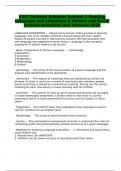Exam (elaborations)
CSET Multiple Subjects Subtest 1 Reading Language and Literature & History and Social Science Questions and Answers 2023
- Course
- Institution
CSET Multiple Subjects Subtest 1 Reading Language and Literature & History and Social Science Questions and Answers 2023
[Show more]



